ASP.NET Core快速入门(第6章:ASP.NET Core MVC)--学习笔记
课程链接:http://video.jessetalk.cn/course/explore
良心课程,大家一起来学习哈!
任务40:介绍
- 1.Individual authentication 模板
- 2.EF Core Migration
- 3.Identity MVC:UI
- 4.Identity MVC: EF + Identity实现
- 5.Identity MVC:注册逻辑实现
- 6.Identity MVC:登录逻辑实现
- 7.Identity MVC:ReturnUrl实现
- 8.Identity MVC:Model后端验证
- 9.Identity MVC:Model前端验证
- 10.Identity MVC:DbContextSeed初始化
任务41:Individual authentication 模板
dotnet new mvc --help
Options:
-au|--auth The type of authentication to use
None - No authentication
Individual - Individual authentication
IndividualB2C - Individual authentication with Azure AD B2C
SingleOrg - Organizational authentication for a single tenant
MultiOrg - Organizational authentication for multiple tenants
Windows - Windows authentication
Default: None
-uld|--use-local-db Whether to use LocalDB instead of SQLite. This option only applies if --auth Individual or --auth IndividualB2C is specified.
bool - Optional
Default: false / (*) true
解决VScode终端乱码
chcp 65001
dotnet new mvc -au Individual -uld --name IdentitySample
默认创建localdb,Identity
appsettings.json
"ConnectionStrings": {
"DefaultConnection": "Server=(localdb)\\mssqllocaldb;Database=aspnet-IdentitySample-40453418-3C8F-43D7-94F8-BD1BD20BDD96;Trusted_Connection=True;MultipleActiveResultSets=true"
}
Startup.cs
services.AddDbContext<ApplicationDbContext>(options =>
options.UseSqlServer(
Configuration.GetConnectionString("DefaultConnection")));
services.AddDefaultIdentity<IdentityUser>(options => options.SignIn.RequireConfirmedAccount = true)
.AddEntityFrameworkStores<ApplicationDbContext>();
初始化数据库,根据Data/Migrations文件夹下的数据库文件创建更新数据库
dotnet ef database update
报错:
无法执行,因为找不到指定的命令或文件。
可能的原因包括:
*你拼错了内置的 dotnet 命令。
*你打算执行 .NET Core 程序,但 dotnet-ef 不存在。
*你打算运行全局工具,但在路径上找不到名称前缀为 dotnet 的可执行文件。
在stackoverflow找到解决方法:
在csproj文件的ItemGroup中添加引用
<DotNetCliToolReference Include="Microsoft.EntityFrameworkCore.Tools.DotNet" Version="2.0.0-preview2-final" />
dotnet restore
dotnet ef database update
dotnet run
访问https://localhost:5001

点击Register进入注册页面
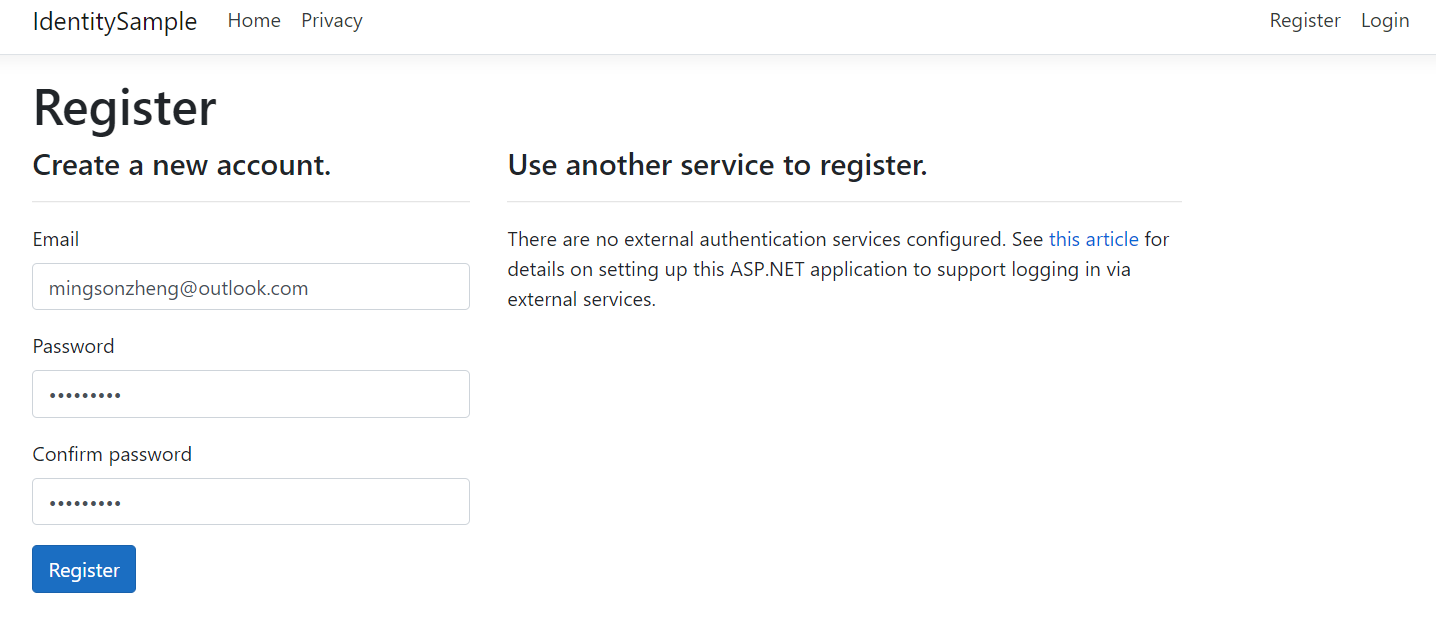
输入邮箱密码登陆

登陆成功

点击邮箱进入Manage your account
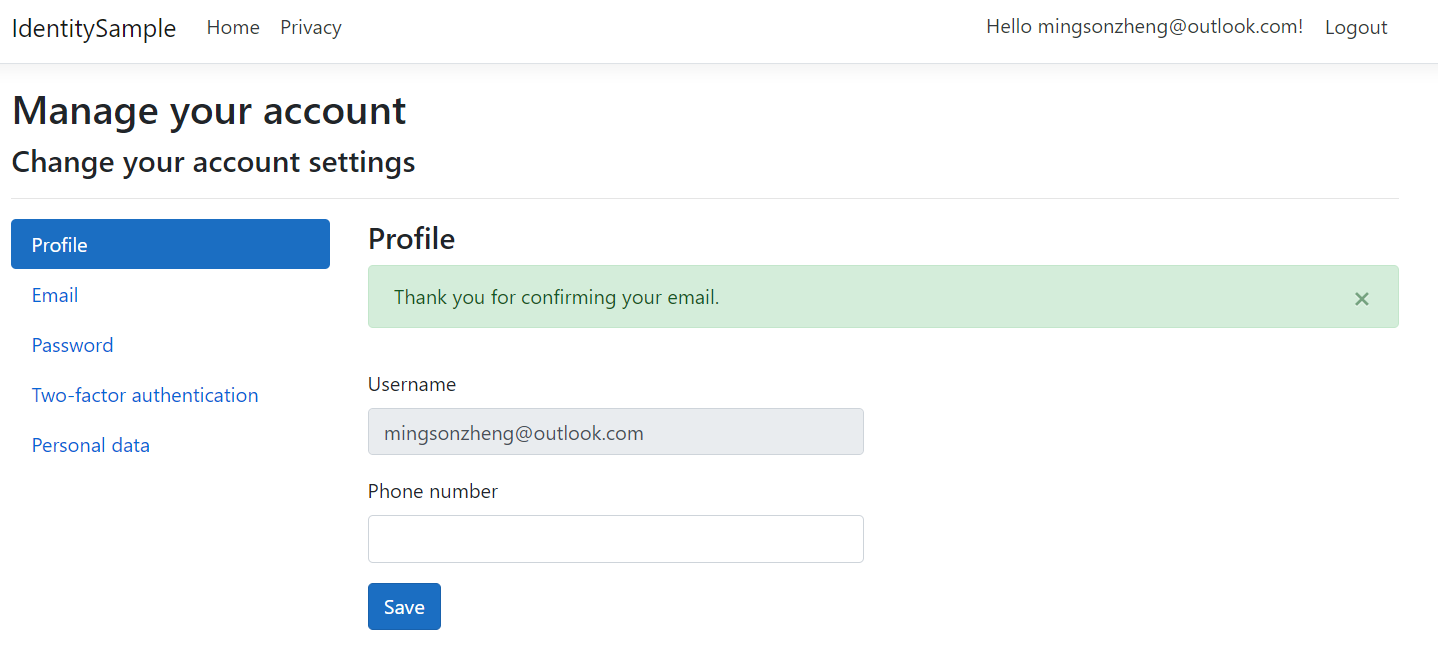
通过SSMS连接localdb
dotnet run
获取实例管道名称
& 'C:\Program Files\Microsoft SQL Server\130\Tools\Binn\SqlLocalDB.exe' info mssqllocaldb
解决PowerShell中文乱码问题,勾选UTF-8
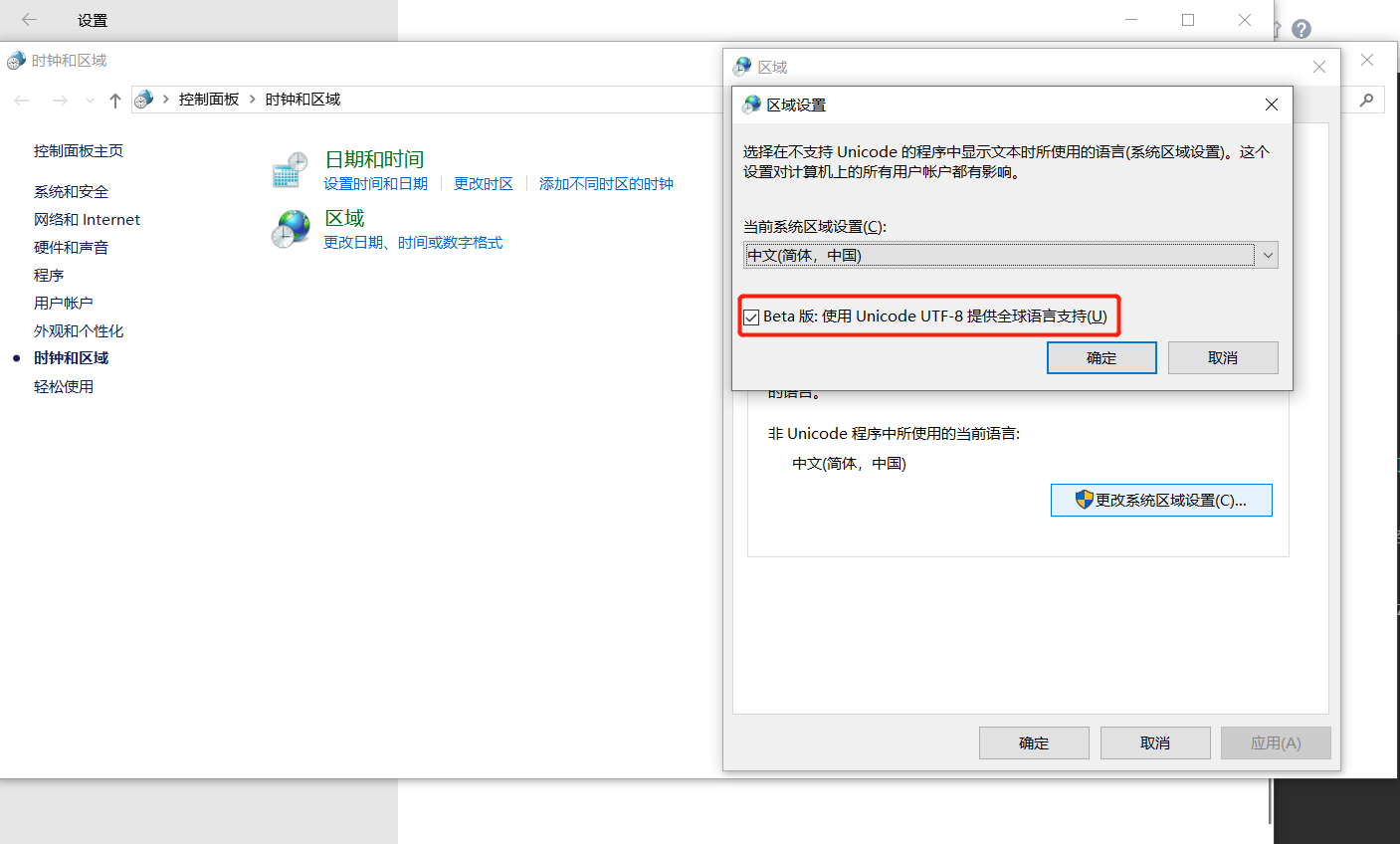
通过实例管道名称连接localdb
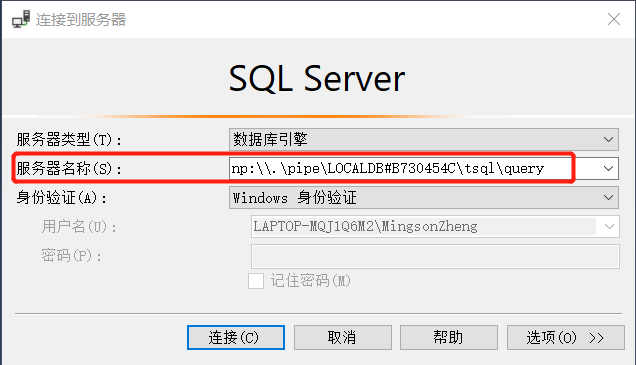

任务42:EF Core Migration
dotnet ef migrations add InitialCreat
dotnet ef database update
dotnet ef migrations remove
dotnet ef database update LastGoodMigration
dotnet ef migrations scrept
数据库新增
添加列之前

在Models文件夹下新增ApplicationUser.cs
using System;
using Microsoft.AspNetCore.Identity;
namespace IdentitySample.Models
{
public class ApplicationUser : IdentityUser
{
public string NewColumn{get;set;}
}
}
dotnet ef migrations add AddNewColumn
自动生成文件

dotnet ef database update
执行成功后刷新数据库,可以看到数据库中多了一列NewColumn
在ApplicationUser.cs中新增Address
public string Address{get;set;}
dotnet ef migrations add AddAddress
dotnet ef database update
执行成功后刷新数据库,可以看到数据库中多了一列Address
数据库回滚
dotnet ef database update AddNewColumn
执行成功后刷新数据库,可以看到数据库中Address不见了
dotnet ef migrations remove
执行成功后移除AddAddress.cs以及AddAddress.Designer.cs文件
生成sql脚本命令
dotnet ef migrations script
拷贝出来后可在数据库执行
任务43:Identity MVC:UI
以MvcCookieAuthSample项目为基础,通过ef core以及Identity实现注册登陆UI整个过程
AccountController.cs新增Register,Login
public IActionResult Register()
{
return View();
}
public IActionResult Login()
{
return View();
}
public IActionResult MakeLogin()
在Views文件夹下新建Account文件夹,在Account文件夹下新增Register.cshtml以及Login.cshtml
Register.cshtml
@{
ViewData["Title"] = "Register";
}
@using MvcCookieAuthSample.ViewModels;
@model RegisterViewModel;
<h2>@ViewData["Title"]</h2>
<h3>@ViewData["Message"]</h3>
<p>Use this area to provide additional information.</p>
<div class="row">
<div class="col-md-4">
<form id="registerForm" method="post" novalidate="novalidate">
<h4>Create a new account.</h4>
<hr>
<div class="form-group">
<label asp-for="Input_Email">Email</label>
<input asp-for="Input_Email" class="form-control" type="email">
</div>
<div class="form-group">
<label asp-for="Input_Password">Password</label>
<input asp-for="Input_Password" class="form-control" type="password">
</div>
<div class="form-group">
<label asp-for="Input_ConfirmPassword">Confirm password</label>
<input asp-for="Input_ConfirmPassword" class="form-control" type="password">
</div>
<button id="registerSubmit" type="submit" class="btn btn-primary">Register</button>
<input name="__RequestVerificationToken" type="hidden" value="CfDJ8HHmKd6uCEtOsAkKHNEfx50wHX7kOnWmAzVSUOOnXiiks-t4chi5eY9XThPYt70X-X6qtCV55TTEowbXbnCAW-91KSw1XVqXqBd48bMdGuVeGHFeZU61gw9jtNtAUDP7gCYnN9J_9d6o5w9sL12jw1E"></form>
</div>
<div class="col-md-6 col-md-offset-2">
<section>
<h4>Use another service to register.</h4>
<hr>
<div>
<p>
There are no external authentication services configured. See <a href="https://go.microsoft.com/fwlink/?LinkID=532715">this article</a>
for details on setting up this ASP.NET application to support logging in via external services.
</p>
</div>
</section>
</div>
</div>
Login.cshtml
@{
ViewData["Title"] = "Login";
}
@using MvcCookieAuthSample.ViewModels;
@model RegisterViewModel;
<div class="row">
<div class="col-md-4">
<section>
<form id="account" method="post" novalidate="novalidate">
<h4>Use a local account to log in.</h4>
<hr>
<div class="form-group">
<label asp-for="Input_Email">Email</label>
<input asp-for="Input_Email" class="form-control" type="email">
</div>
<div class="form-group">
<label asp-for="Input_Password">Password</label>
<input asp-for="Input_Password" class="form-control" type="password">
</div>
<div class="form-group">
<button id="login-submit" type="submit" class="btn btn-primary">Log in</button>
</div>
<input name="__RequestVerificationToken" type="hidden" value="CfDJ8HHmKd6uCEtOsAkKHNEfx514_36YMa9FLgbR-vliay5DWvu05X4yejzvlNz6ULPfevJg9b12mlIjiWYP9ifLswnUdt43dzUmlvJzsanhL7RHmQMDAwrKRRTJWtaHJ4qbHUNyldkz95mHRrvivNTez9I"><input name="Input.RememberMe" type="hidden" value="false"></form>
</section>
</div>
</div>
新建ViewModels文件夹,在ViewModels文件夹下新建RegisterViewModel.cs
RegisterViewModel.cs
namespace MvcCookieAuthSample.ViewModels
{
public class RegisterViewModel
{
public string Input_Email{get;set;}
public string Input_Password{get;set;}
public string Input_ConfirmPassword{get;set;}
}
}
在Views/Shared目录下的_Layout.cshtml中增加Register以及Login
<div class="navbar-collapse collapse">
<ul class="nav navbar-nav">
<li><a asp-area="" asp-controller="Home" asp-action="Index">Home</a></li>
<li><a asp-area="" asp-controller="Home" asp-action="About">About</a></li>
<li><a asp-area="" asp-controller="Home" asp-action="Contact">Contact</a></li>
</ul>
<ul class="nav navbar-nav navbar-right">
<li><a asp-area="" asp-controller="Account" asp-action="Register">Register</a></li>
<li><a asp-area="" asp-controller="Account" asp-action="Login">Login</a></li>
</ul>
</div>
dotnet run
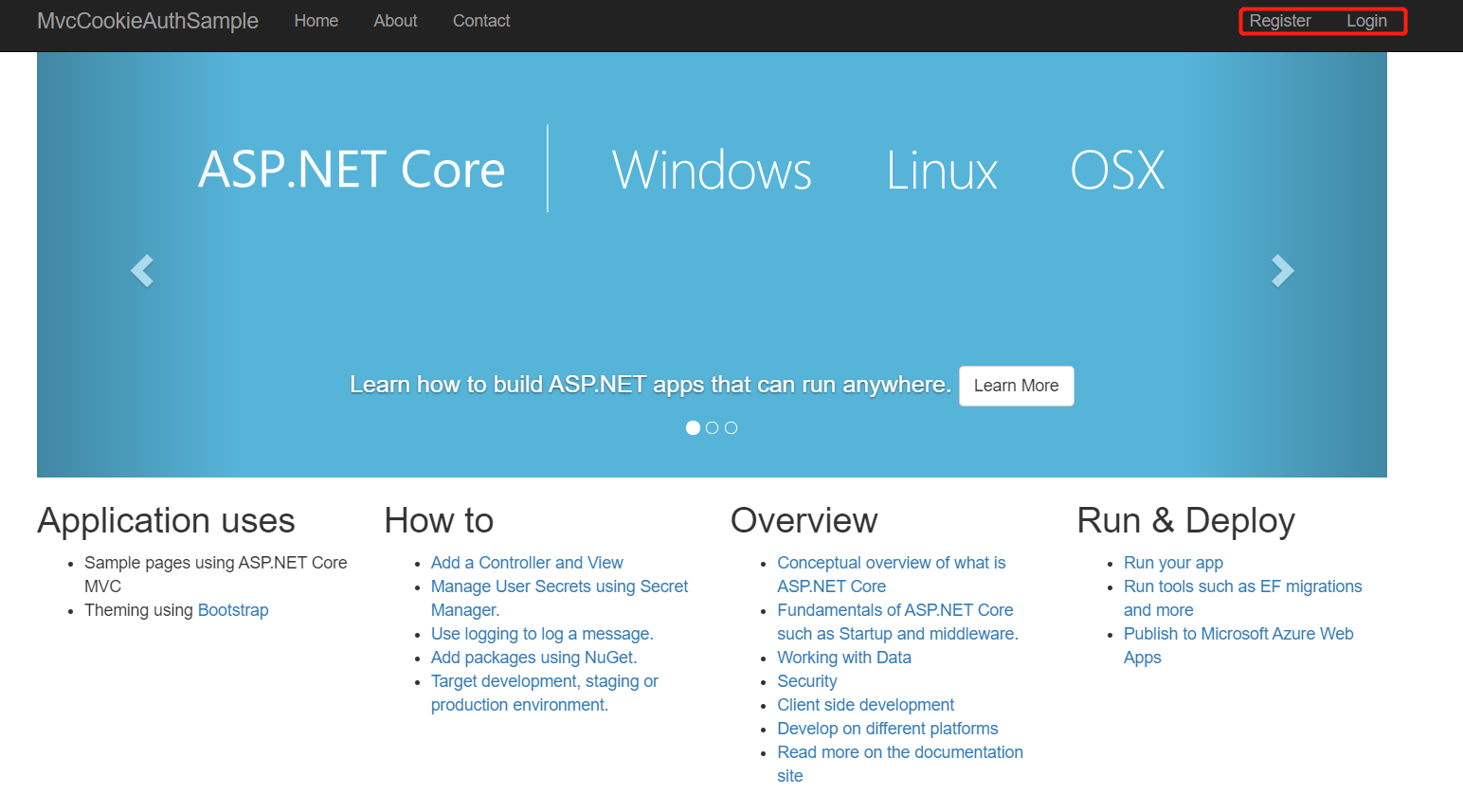
点击进入Register以及Login页面
任务44:Identity MVC: EF + Identity实现
在Models文件夹新增ApplicationUser.cs以及ApplicationUserRole.cs
ApplicationUser.cs
using Microsoft.AspNetCore.Identity;
namespace MvcCookieAuthSample.Models
{
// 默认主键GUID,可通过泛型修改
public class ApplicationUser : IdentityUser<int>
{
}
}
ApplicationUserRole.cs
using Microsoft.AspNetCore.Identity;
namespace MvcCookieAuthSample.Models
{
// 默认主键GUID,可通过泛型修改
public class ApplicationUserRole : IdentityRole<int>
{
}
}
新建Data文件夹,在Data文件夹下新建ApplicationDbContext.cs
using Microsoft.EntityFrameworkCore;
using Microsoft.AspNetCore.Identity.EntityFrameworkCore;
using MvcCookieAuthSample.Models;
namespace MvcCookieAuthSample.Data
{
public class ApplicationDbContext : IdentityDbContext<ApplicationUser, ApplicationUserRole, int>
{
public ApplicationDbContext(DbContextOptions<ApplicationDbContext> options) : base(options)
{
}
}
}
在appsettings.json中添加ConnectionStrings
{
"Logging": {
"LogLevel": {
"Default": "Warning"
}
},
"AllowedHosts": "*",
"ConnectionStrings": {
"DefaultConnection": "Server=(localdb)\\mssqllocaldb;Database=aspnet-IdentitySample-81D77053-883E-44D8-A94D-195B9C54C2B6;Trusted_Connection=True;MultipleActiveResultSets=true"
}
}
Startup.cs添加以下内容
using MvcCookieAuthSample.Data;
using Microsoft.EntityFrameworkCore;
using MvcCookieAuthSample.Models;
using Microsoft.AspNetCore.Identity;
public void ConfigureServices(IServiceCollection services)
{
// services.Configure<CookiePolicyOptions>(options =>
// {
// // This lambda determines whether user consent for non-essential cookies is needed for a given request.
// options.CheckConsentNeeded = context => true;
// options.MinimumSameSitePolicy = SameSiteMode.None;
// });
services.AddDbContext<ApplicationDbContext>(options =>
{
options.UseSqlServer(Configuration.GetConnectionString("DefaultConnection"));
});
services.AddIdentity<ApplicationUser, ApplicationUserRole>()
.AddEntityFrameworkStores<ApplicationDbContext>()
.AddDefaultTokenProviders();
// Addmvc之前AddAuthentication,AddCookie
// services.AddAuthentication(CookieAuthenticationDefaults.AuthenticationScheme)
// .AddCookie();
services.AddAuthentication(CookieAuthenticationDefaults.AuthenticationScheme)
.AddCookie(options =>
{
options.LoginPath = "/Account/Login";
});
services.Configure<IdentityOptions>(options =>
{
options.Password.RequireLowercase = false;
options.Password.RequireNonAlphanumeric = false;
options.Password.RequireUppercase = false;
});
//services.AddMvc().SetCompatibilityVersion(CompatibilityVersion.Version_2_1);
services.AddMvc();
}
AccountController.cs添加以下内容
using MvcCookieAuthSample.ViewModels;
using Microsoft.AspNetCore.Identity;
//[Authorize]
public class AccountController : Controller
private UserManager<ApplicationUser> _userManager;
private SignInManager<ApplicationUser> _signInManager;
public AccountController(UserManager<ApplicationUser> userManager, SignInManager<ApplicationUser> signInManager)
{
_userManager = userManager;
_signInManager = signInManager;
}
[HttpPost]
public async Task<IActionResult> Register(RegisterViewModel registerViewModel)
{
var identityUser = new ApplicationUser
{
Email = registerViewModel.Input_Email,
UserName = registerViewModel.Input_Email,
NormalizedEmail = registerViewModel.Input_Email
};
var identityResult = await _userManager.CreateAsync(identityUser, registerViewModel.Input_Password);
if (identityResult.Succeeded)
{
return RedirectToAction("Index", "Home");
}
return View();
}
添加nuget包:Microsoft.EntityFrameworkCore.Tools
VSCode报错:Versioning information could not be retrieved from the NuGet package repository. Please try again later.
使用Visual Studio添加nuget包
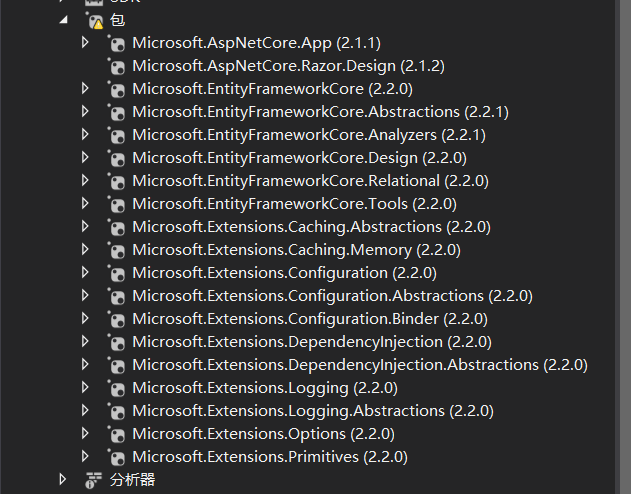
dotnet ef migrations add VSInit
dotnet ef database update
报错:There is already an object named 'AspNetRoles' in the database.
删除之前的数据库实例
dotnet ef migrations add VSInit
dotnet ef database update
主键为int
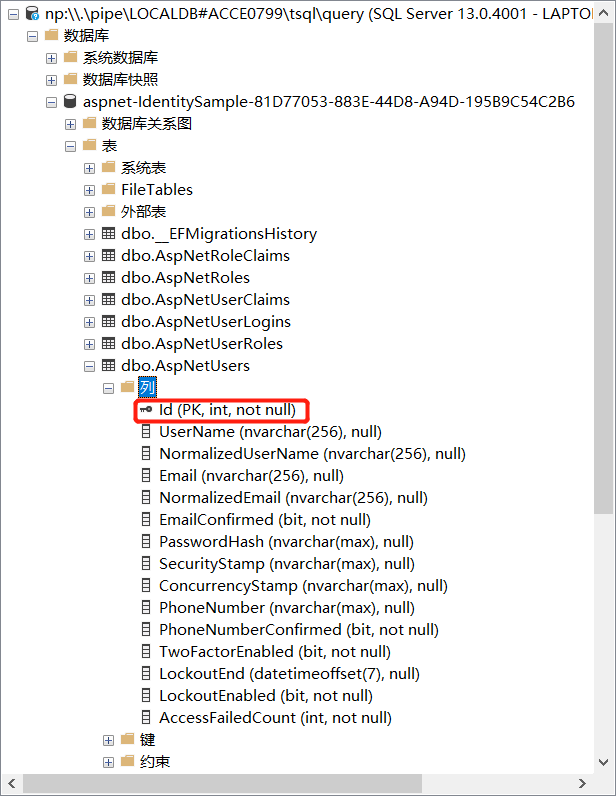
dotnet run
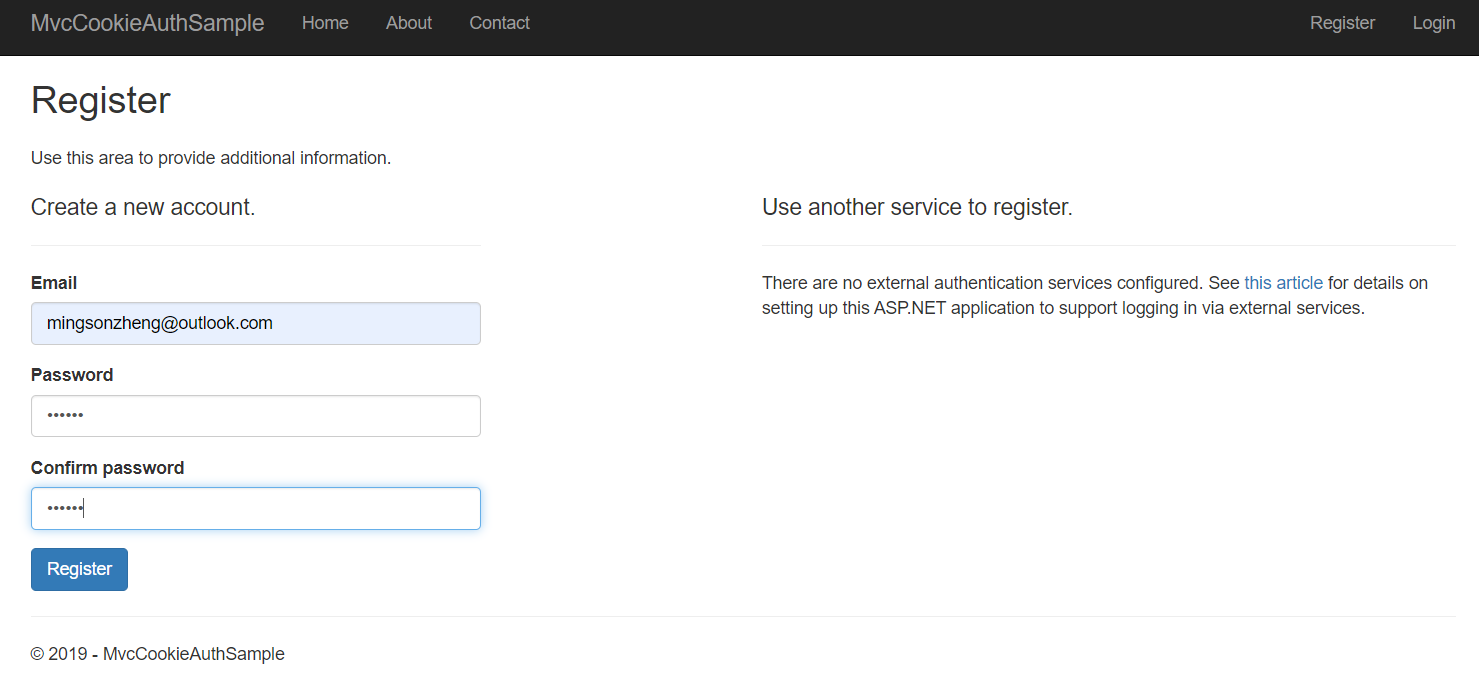
点击Register,成功跳回主页
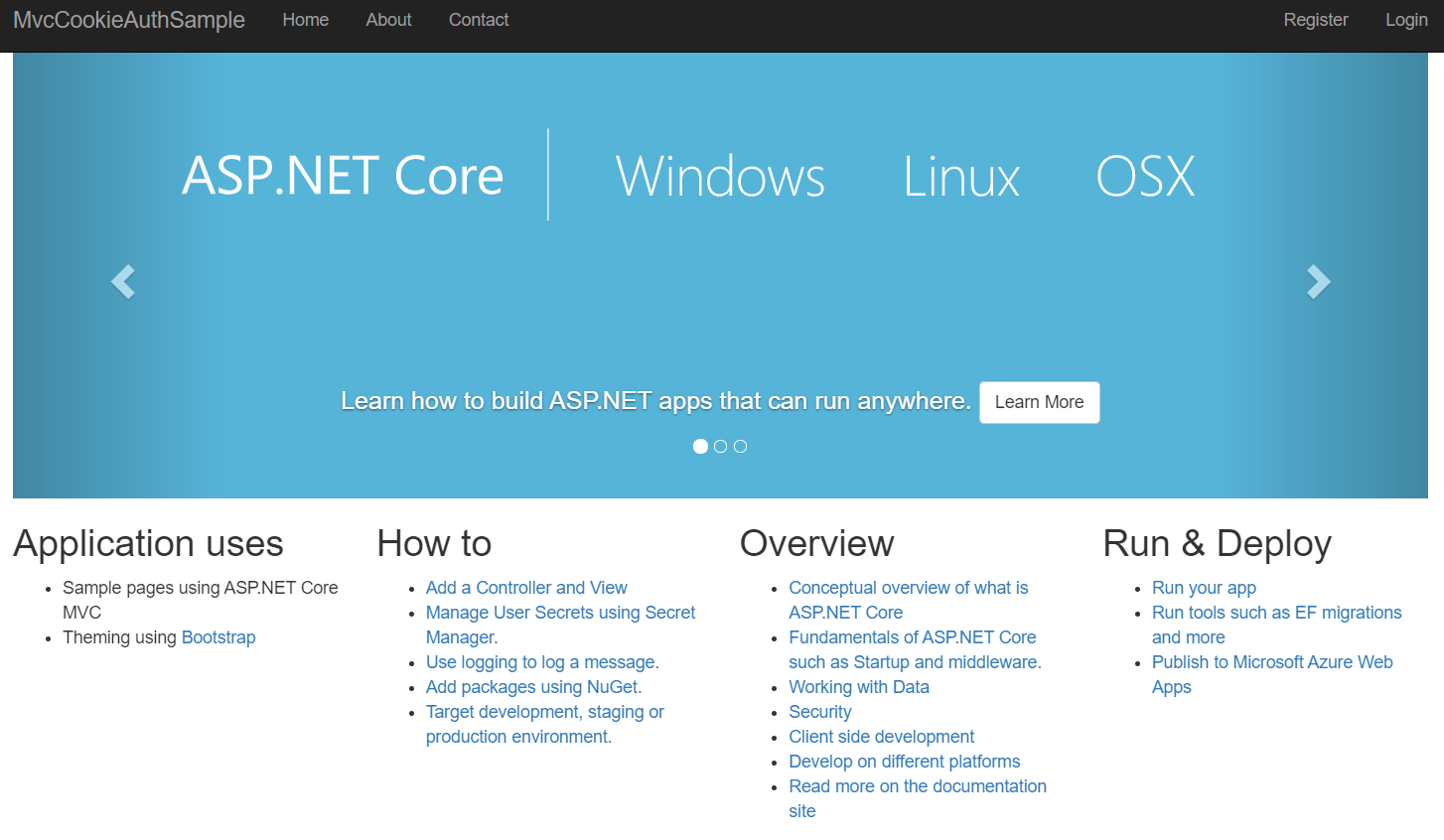
在数据库中查看数据
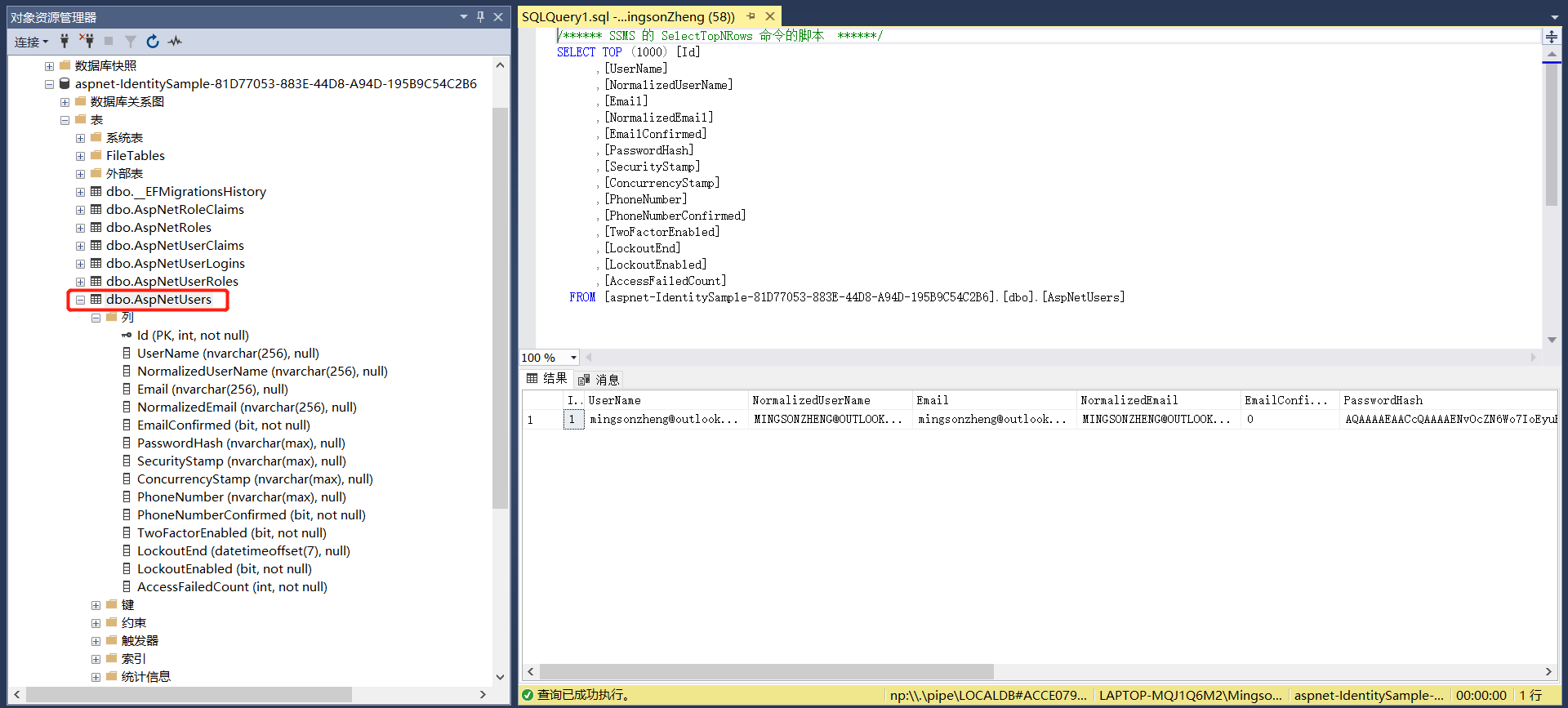
任务45:Identity MVC:注册逻辑实现
AccountController.cs
[HttpPost]
public async Task<IActionResult> Register(RegisterViewModel registerViewModel)
{
var identityUser = new ApplicationUser
{
Email = registerViewModel.Input_Email,
UserName = registerViewModel.Input_Email,
NormalizedEmail = registerViewModel.Input_Email
};
var identityResult = await _userManager.CreateAsync(identityUser, registerViewModel.Input_Password);
if (identityResult.Succeeded)
{
// 封装了下面MakeLogin()方法中的HttpContext.SignInAsync(CookieAuthenticationDefaults.AuthenticationScheme,new ClaimsPrincipal(claimIdentity));
await _signInManager.SignInAsync(identityUser, new AuthenticationProperties {IsPersistent = true});
return RedirectToAction("Index", "Home");
}
return View();
}
启动项目,重新注册一个

看到Cookie,登陆成功

修改Views/Shared文件夹下的_Layout.cshtml
<div class="navbar-collapse collapse">
<ul class="nav navbar-nav">
<li><a asp-area="" asp-controller="Home" asp-action="Index">Home</a></li>
<li><a asp-area="" asp-controller="Home" asp-action="About">About</a></li>
<li><a asp-area="" asp-controller="Home" asp-action="Contact">Contact</a></li>
</ul>
<ul class="nav navbar-nav navbar-right">
@if (User.Identity.IsAuthenticated)
{
<li>Welcome, @User.Identity.Name, <a asp-area="" asp-controller="Account" asp-action="Logout">Logout</a></li>
}
else
{
<li><a asp-area="" asp-controller="Account" asp-action="Register">Register</a></li>
<li><a asp-area="" asp-controller="Account" asp-action="Login">Login</a></li>
}
</ul>
</div>
启动项目

任务46:Identity MVC:登录逻辑实现
AccountController.cs
[HttpPost]
public async Task<IActionResult> Login(RegisterViewModel loginViewModel)
{
var user = await _userManager.FindByEmailAsync(loginViewModel.Input_Email);
if (user == null)
{
}
await _signInManager.SignInAsync(user, new AuthenticationProperties {IsPersistent = true});
return RedirectToAction("Index", "Home");
}
public async Task<IActionResult> Logout()
{
await _signInManager.SignOutAsync();
return RedirectToAction("Index", "Home");
}
//public IActionResult Logout()
//{
// HttpContext.SignOutAsync(CookieAuthenticationDefaults.AuthenticationScheme);
// return Ok();
//}
_Layout.cshtml
<div class="navbar-collapse collapse">
<ul class="nav navbar-nav">
<li><a asp-area="" asp-controller="Home" asp-action="Index">Home</a></li>
<li><a asp-area="" asp-controller="Home" asp-action="About">About</a></li>
<li><a asp-area="" asp-controller="Home" asp-action="Contact">Contact</a></li>
</ul>
@if (User.Identity.IsAuthenticated)
{
<form asp-action="Logout" asp-controller="Account" method="post">
<ul class="nav navbar-nav navbar-right">
<li><a title="Welcome" asp-controller="Admin" asp-action="Index"> @User.Identity.Name, </a></li>
<li><button type="submit" class="btn btn-link navbar-btn navbar-link">Log out</button></li>
</ul>
</form>
}
else
{
<ul class="nav navbar-nav navbar-right">
<li><a asp-area="" asp-controller="Account" asp-action="Register">Register</a></li>
<li><a asp-area="" asp-controller="Account" asp-action="Login">Login</a></li>
</ul>
}
</div>
Views/Account文件夹中的Login.cshtml
<form id="account" method="post" asp-controller="Account" asp-action="Login" novalidate="novalidate">
启动项目

点击Log out,回到主页

点击Login

登陆成功
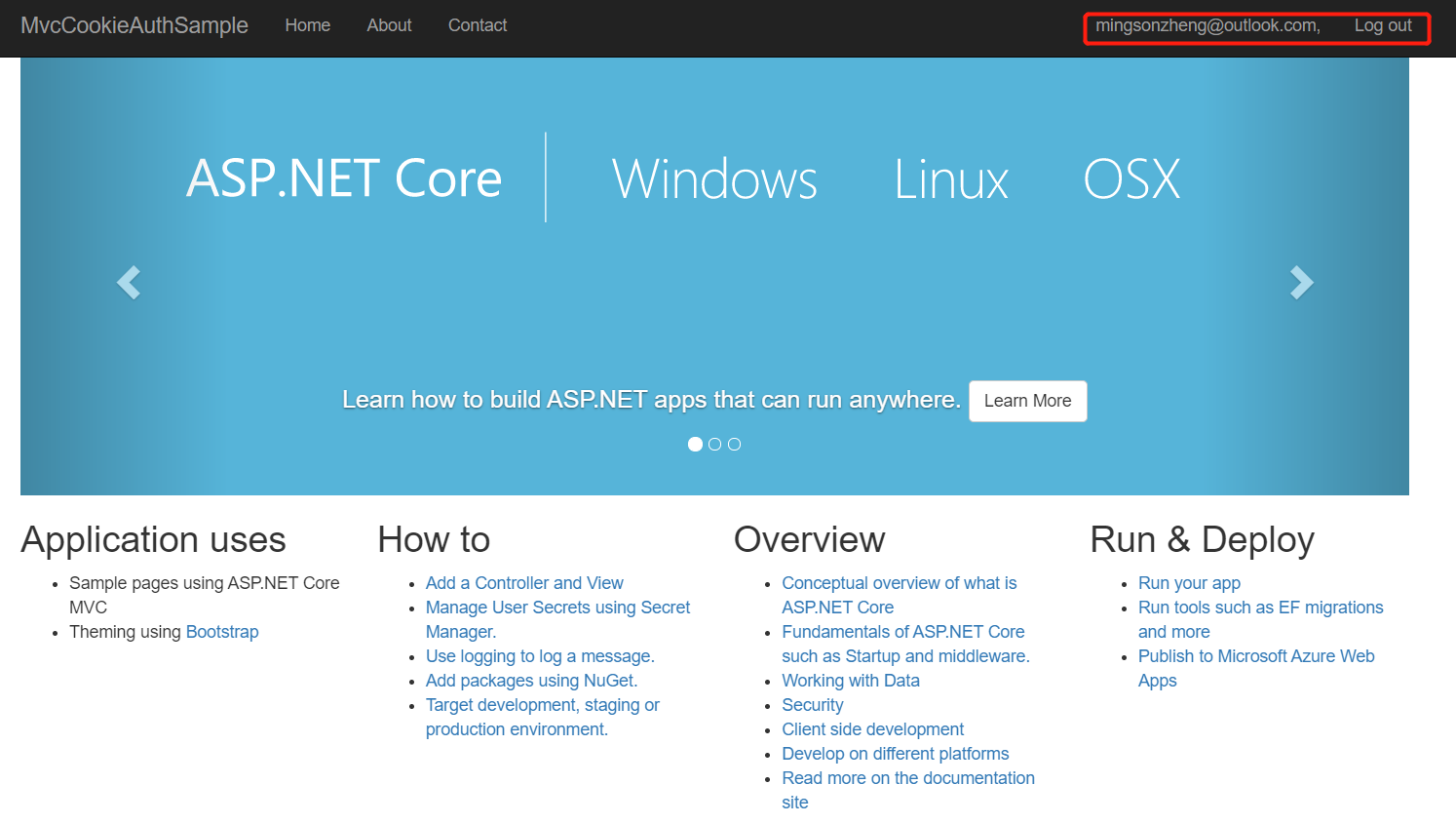
换另一个邮箱,登陆成功
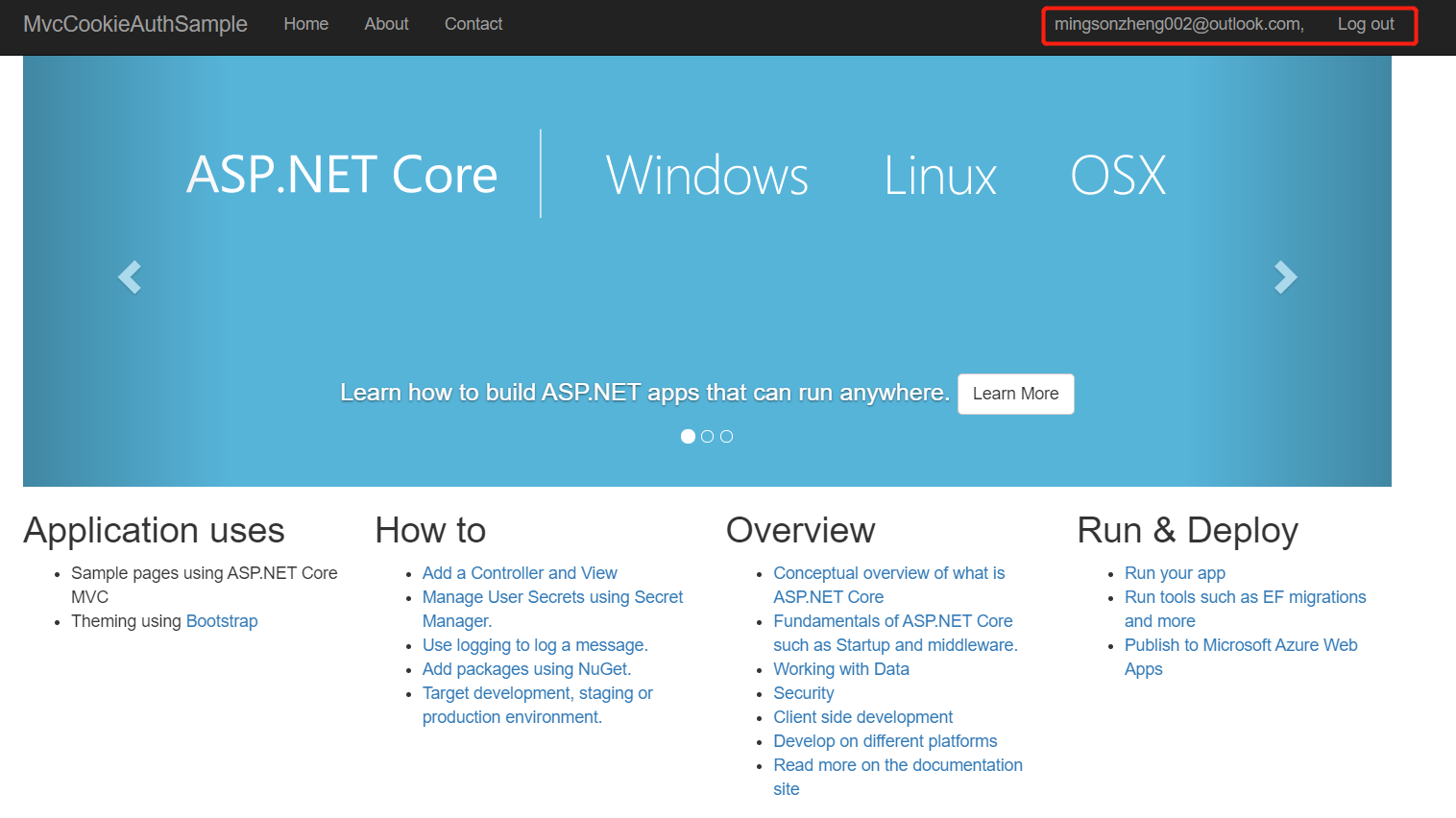
任务47:Identity MVC:ReturnUrl实现
AccountController.cs
private IActionResult RedirectToLocal(string returnUrl)
{
if (Url.IsLocalUrl(returnUrl))
return Redirect(returnUrl);
return RedirectToAction(nameof(HomeController.Index), "Home");
}
public IActionResult Register(string returnUrl = null)
{
ViewData["ReturnUrl"] = returnUrl;
return View();
}
[HttpPost]
public async Task<IActionResult> Register(RegisterViewModel registerViewModel, string returnUrl = null)
{
ViewData["ReturnUrl"] = returnUrl;
var identityUser = new ApplicationUser
{
Email = registerViewModel.Input_Email,
UserName = registerViewModel.Input_Email,
NormalizedEmail = registerViewModel.Input_Email
};
var identityResult = await _userManager.CreateAsync(identityUser, registerViewModel.Input_Password);
if (identityResult.Succeeded)
{
// 封装了下面MakeLogin()方法中的HttpContext.SignInAsync(CookieAuthenticationDefaults.AuthenticationScheme,new ClaimsPrincipal(claimIdentity));
await _signInManager.SignInAsync(identityUser, new AuthenticationProperties {IsPersistent = true});
//return RedirectToAction("Index", "Home");
return RedirectToLocal(returnUrl);
}
return View();
}
public IActionResult Login(string returnUrl = null)
{
ViewData["ReturnUrl"] = returnUrl;
return View();
}
[HttpPost]
public async Task<IActionResult> Login(RegisterViewModel loginViewModel, string returnUrl = null)
{
ViewData["ReturnUrl"] = returnUrl;
var user = await _userManager.FindByEmailAsync(loginViewModel.Input_Email);
if (user == null)
{
}
await _signInManager.SignInAsync(user, new AuthenticationProperties {IsPersistent = true});
//return RedirectToAction("Index", "Home");
return RedirectToLocal(returnUrl);
}
Register.cshtml
<form id="registerForm" method="post" asp-route-returnUrl="@ViewData["ReturnUrl"]" novalidate="novalidate">
Login.cshtml
<form id="account" method="post" asp-controller="Account" asp-action="Login" asp-route-returnUrl="@ViewData["ReturnUrl"]" novalidate="novalidate">
启动项目,访问:https://localhost:44387/admin

点击Log out,再次访问:https://localhost:44387/admin,跳转到登陆界面
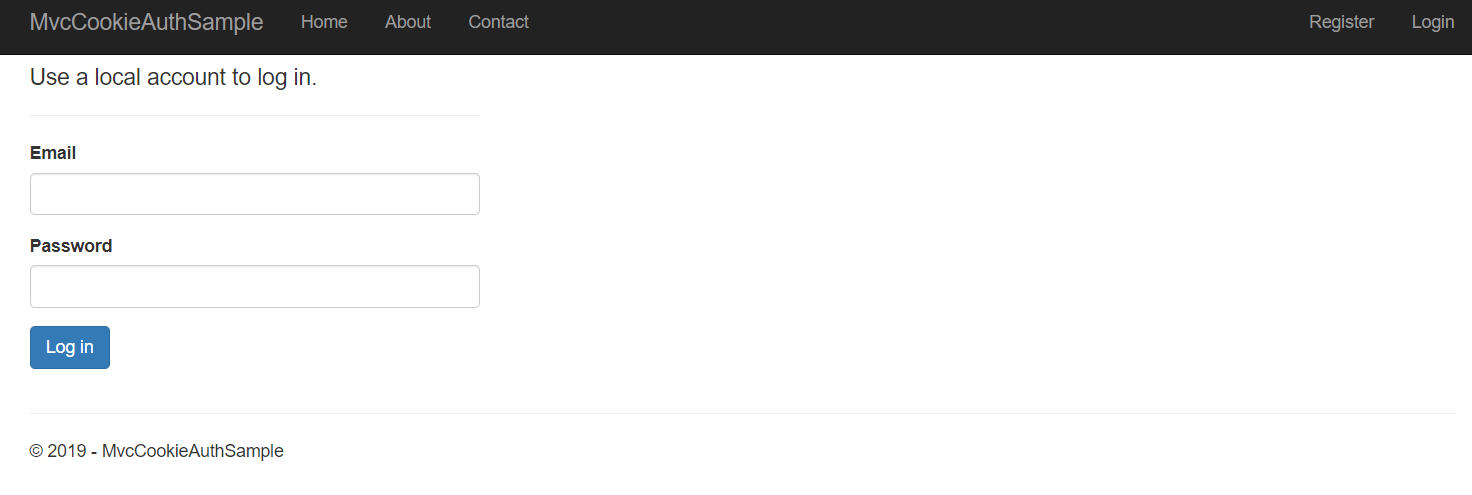
登陆之后直接到admin页面

任务48:Identity MVC:Model后端验证
RegisterViewModel.cs
using System.ComponentModel.DataAnnotations;
namespace MvcCookieAuthSample.ViewModels
{
public class RegisterViewModel
{
[Required]
[DataType(DataType.EmailAddress)]
public string Input_Email{get;set;}
[Required]
[DataType(DataType.Password)]
public string Input_Password{get;set;}
[Required]
[DataType(DataType.Password)]
public string Input_ConfirmPassword{get;set;}
}
}
在ViewModels文件夹下新增LoginViewModel.cs
using System;
using System.Collections.Generic;
using System.Linq;
using System.Threading.Tasks;
using System.ComponentModel.DataAnnotations;
namespace MvcCookieAuthSample.ViewModels
{
public class LoginViewModel
{
[Required]
[DataType(DataType.EmailAddress)]
public string Input_Email { get; set; }
[Required]
[DataType(DataType.Password)]
public string Input_Password { get; set; }
}
}
AccountController.cs第一个参数类型由RegisterViewModel修改为LoginViewModel
[HttpPost]
public async Task<IActionResult> Login(LoginViewModel loginViewModel, string returnUrl = null)
{
if (ModelState.IsValid)
{
ViewData["ReturnUrl"] = returnUrl;
var user = await _userManager.FindByEmailAsync(loginViewModel.Input_Email);
if (user == null)
{
}
await _signInManager.SignInAsync(user, new AuthenticationProperties { IsPersistent = true });
//return RedirectToAction("Index", "Home");
return RedirectToLocal(returnUrl);
}
return View();
}
Login.cshtml
<div class="form-group">
<label asp-for="Input_Email">Email</label>
<input asp-for="Input_Email" class="form-control" type="email">
<span asp-validation-for="Input_Email" class="text-danger"></span>
</div>
<div class="form-group">
<label asp-for="Input_Password">Password</label>
<input asp-for="Input_Password" class="form-control" type="password">
<span asp-validation-for="Input_Password" class="text-danger"></span>
</div>
启动项目,不输入邮箱密码直接点击登陆
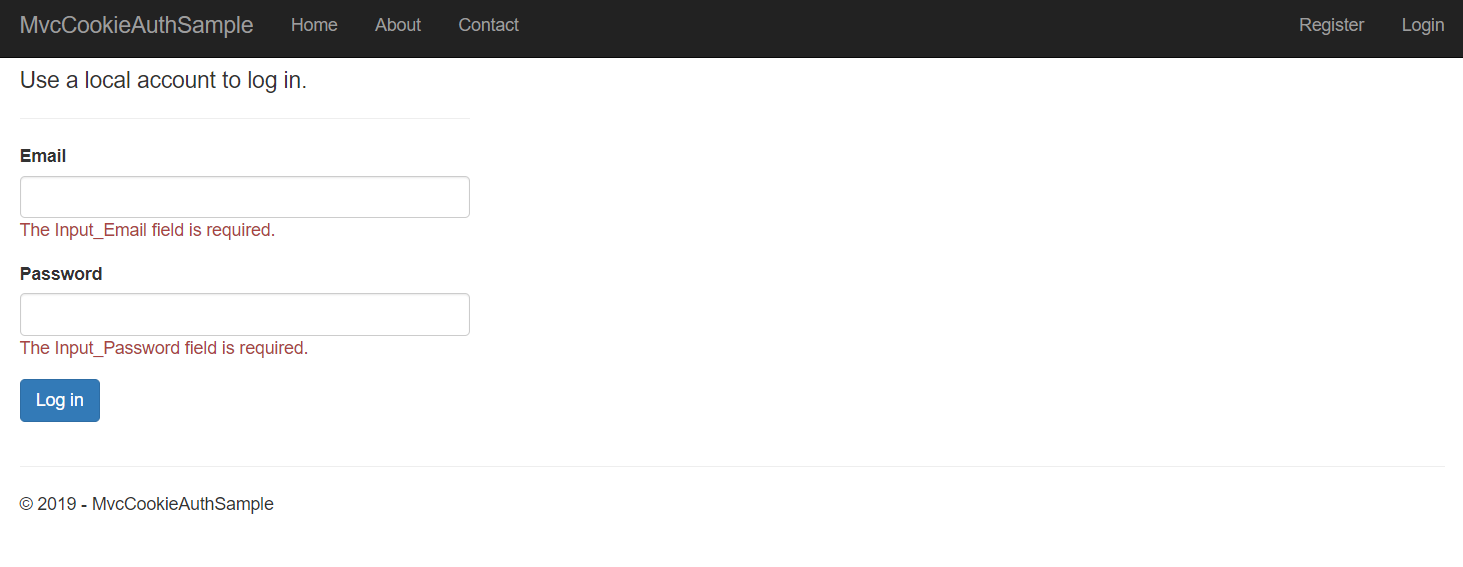
Register.cshtml
<div class="form-group">
<label asp-for="Input_Email">Email</label>
<input asp-for="Input_Email" class="form-control" type="email">
<span asp-validation-for="Input_Email" class="text-danger"></span>
</div>
<div class="form-group">
<label asp-for="Input_Password">Password</label>
<input asp-for="Input_Password" class="form-control" type="password">
<span asp-validation-for="Input_Password" class="text-danger"></span>
</div>
<div class="form-group">
<label asp-for="Input_ConfirmPassword">Confirm password</label>
<input asp-for="Input_ConfirmPassword" class="form-control" type="password">
<span asp-validation-for="Input_ConfirmPassword" class="text-danger"></span>
</div>
AccountController.cs
[HttpPost]
public async Task<IActionResult> Register(RegisterViewModel registerViewModel, string returnUrl = null)
{
if (ModelState.IsValid)
{
ViewData["ReturnUrl"] = returnUrl;
var identityUser = new ApplicationUser
{
Email = registerViewModel.Input_Email,
UserName = registerViewModel.Input_Email,
NormalizedEmail = registerViewModel.Input_Email
};
var identityResult = await _userManager.CreateAsync(identityUser, registerViewModel.Input_Password);
if (identityResult.Succeeded)
{
// 封装了下面MakeLogin()方法中的HttpContext.SignInAsync(CookieAuthenticationDefaults.AuthenticationScheme,new ClaimsPrincipal(claimIdentity));
await _signInManager.SignInAsync(identityUser, new AuthenticationProperties { IsPersistent = true });
//return RedirectToAction("Index", "Home");
return RedirectToLocal(returnUrl);
}
}
return View();
}
启动项目,直接点击注册

Startup.cs
services.Configure<IdentityOptions>(options =>
{
options.Password.RequireLowercase = true;
options.Password.RequireNonAlphanumeric = true;
options.Password.RequireUppercase = true;
options.Password.RequiredLength = 12;
});
Register.cshtml添加text-danger
<h4>Create a new account.</h4>
<hr>
<div class="text-danger" asp-validation-summary="All"></div>
AccountController.cs
private void AddErrors(IdentityResult result)
{
foreach (var error in result.Errors)
{
ModelState.AddModelError(string.Empty, error.Description);
}
}
[HttpPost]
public async Task<IActionResult> Register(RegisterViewModel registerViewModel, string returnUrl = null)
{
if (ModelState.IsValid)
{
ViewData["ReturnUrl"] = returnUrl;
var identityUser = new ApplicationUser
{
Email = registerViewModel.Input_Email,
UserName = registerViewModel.Input_Email,
NormalizedEmail = registerViewModel.Input_Email
};
var identityResult = await _userManager.CreateAsync(identityUser, registerViewModel.Input_Password);
if (identityResult.Succeeded)
{
// 封装了下面MakeLogin()方法中的HttpContext.SignInAsync(CookieAuthenticationDefaults.AuthenticationScheme,new ClaimsPrincipal(claimIdentity));
await _signInManager.SignInAsync(identityUser, new AuthenticationProperties { IsPersistent = true });
//return RedirectToAction("Index", "Home");
return RedirectToLocal(returnUrl);
}
else
{
AddErrors(identityResult);
}
}
return View();
}
启动项目,随便输入密码123

点击注册
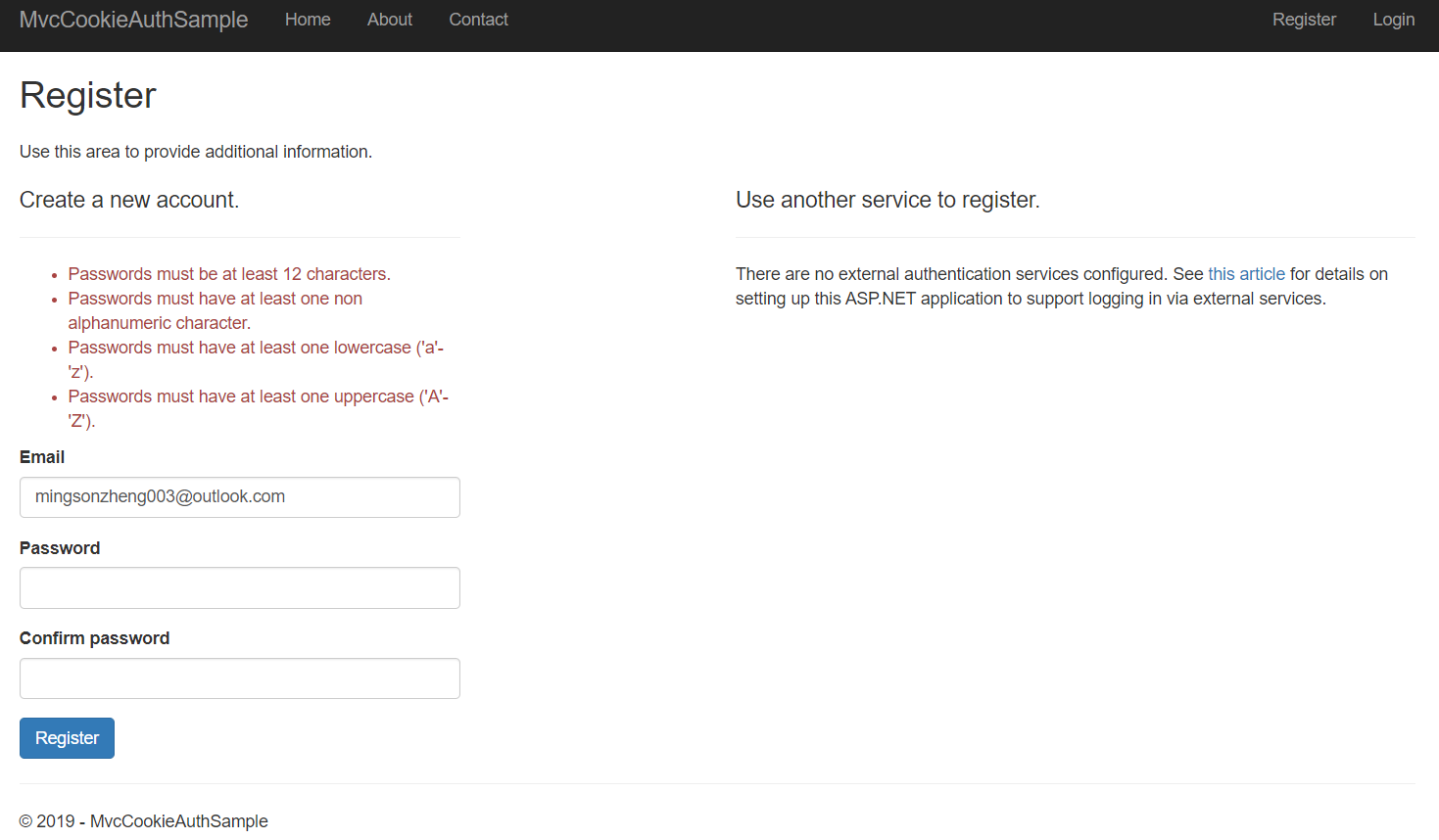
任务49:Identity MVC:Model前端验证
将Shared文件夹中的_ValidationScriptsPartial.cshtml的jquery.validate组件添加到Login.cshtml最下面以及Register.cshtml最下面
@section Scripts
{
@await Html.PartialAsync("_ValidationScriptsPartial")
}
启动项目,直接点击登陆,注册,不会产生网络请求
任务50:Identity MVC:DbContextSeed初始化
启动的时候判断是否第一次执行,如果第一次执行则添加一个记录,比如用户账号第一次进来为管理员
在Data文件夹新增ApplicationDbContextSeed.cs
using System;
using System.Collections.Generic;
using System.Linq;
using System.Threading.Tasks;
using Microsoft.AspNetCore.Identity;
using MvcCookieAuthSample.Models;
using Microsoft.Extensions.DependencyInjection;
namespace MvcCookieAuthSample.Data
{
public class ApplicationDbContextSeed
{
private UserManager<ApplicationUser> _userManager;
public async Task SeedSync(ApplicationDbContext context, IServiceProvider services)
{
if (!context.Users.Any())
{
_userManager = services.GetRequiredService<UserManager<ApplicationUser>>();
var defaultUser = new ApplicationUser
{
UserName = "Administrator",
Email = "mingsonzheng003@outlook.com",
NormalizedUserName = "admin"
};
var result = await _userManager.CreateAsync(defaultUser, "Password$123");
if (!result.Succeeded)
throw new Exception("初始默认用户失败");
}
}
}
}
在Data文件夹新增扩展方法调用ApplicationDbContextSeed
WebHostMigrationExtensions.cs
using System;
using System.Collections.Generic;
using System.Linq;
using System.Threading.Tasks;
using Microsoft.AspNetCore.Hosting;
using Microsoft.EntityFrameworkCore;
using Microsoft.Extensions.DependencyInjection;
using Microsoft.Extensions.Logging;
namespace MvcCookieAuthSample.Data
{
public static class WebHostMigrationExtensions
{
public static IWebHost MigrateDbContext<TContext>(this IWebHost host, Action<TContext, IServiceProvider> sedder)
where TContext : DbContext
{
using (var scope = host.Services.CreateScope())
{
var services = scope.ServiceProvider;
var logger = services.GetRequiredService<ILogger<TContext>>();
var context = services.GetService<TContext>();
try
{
context.Database.Migrate();
sedder(context, services);
logger.LogInformation($"执行DBContext { typeof(TContext).Name } seed执行成功");
}
catch (Exception ex)
{
logger.LogInformation($"执行DBContext { typeof(TContext).Name } seed执行失败");
}
}
return host;
}
}
}
Program.cs
using System;
using System.Collections.Generic;
using System.IO;
using System.Linq;
using System.Threading.Tasks;
using Microsoft.AspNetCore;
using Microsoft.AspNetCore.Hosting;
using Microsoft.Extensions.Configuration;
using Microsoft.Extensions.Logging;
using MvcCookieAuthSample.Data;
namespace MvcCookieAuthSample
{
public class Program
{
public static void Main(string[] args)
{
CreateWebHostBuilder(args).Build()
.MigrateDbContext<ApplicationDbContext>((context, services) =>
{
new ApplicationDbContextSeed().SeedSync(context, services)
.Wait();
})
.Run();
}
public static IWebHostBuilder CreateWebHostBuilder(string[] args) =>
WebHost.CreateDefaultBuilder(args)
.UseStartup<Startup>();
}
}
删除数据库

控制台方式启动项目,先进行数据库初始化,再启动WebHost

数据库自动插入数据

输入邮箱,密码:Password$123
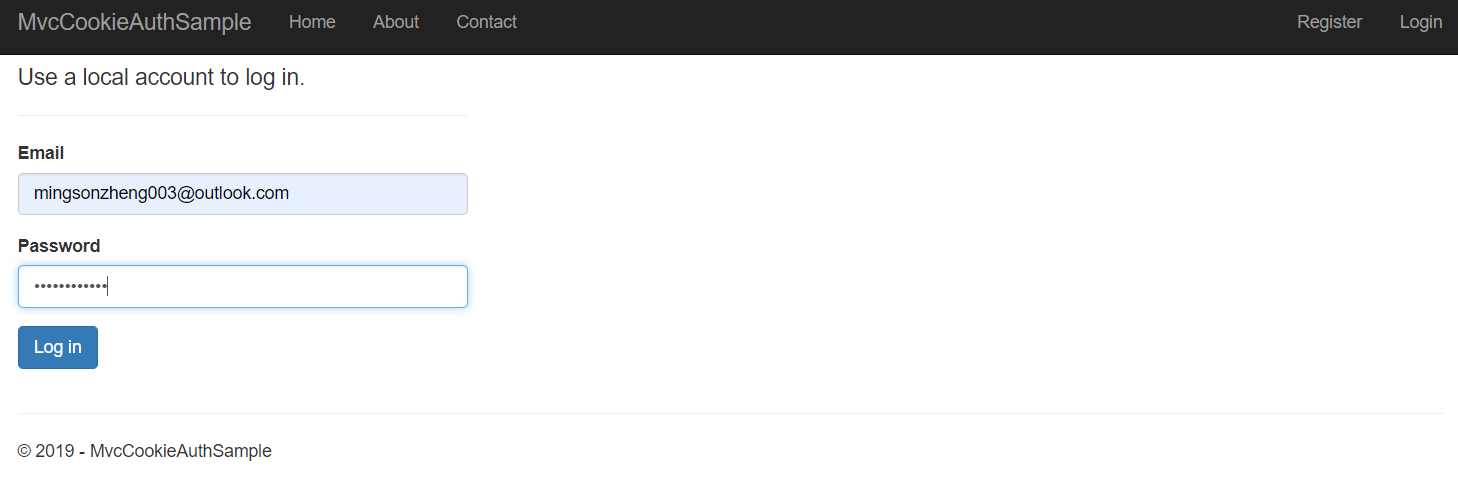
登陆
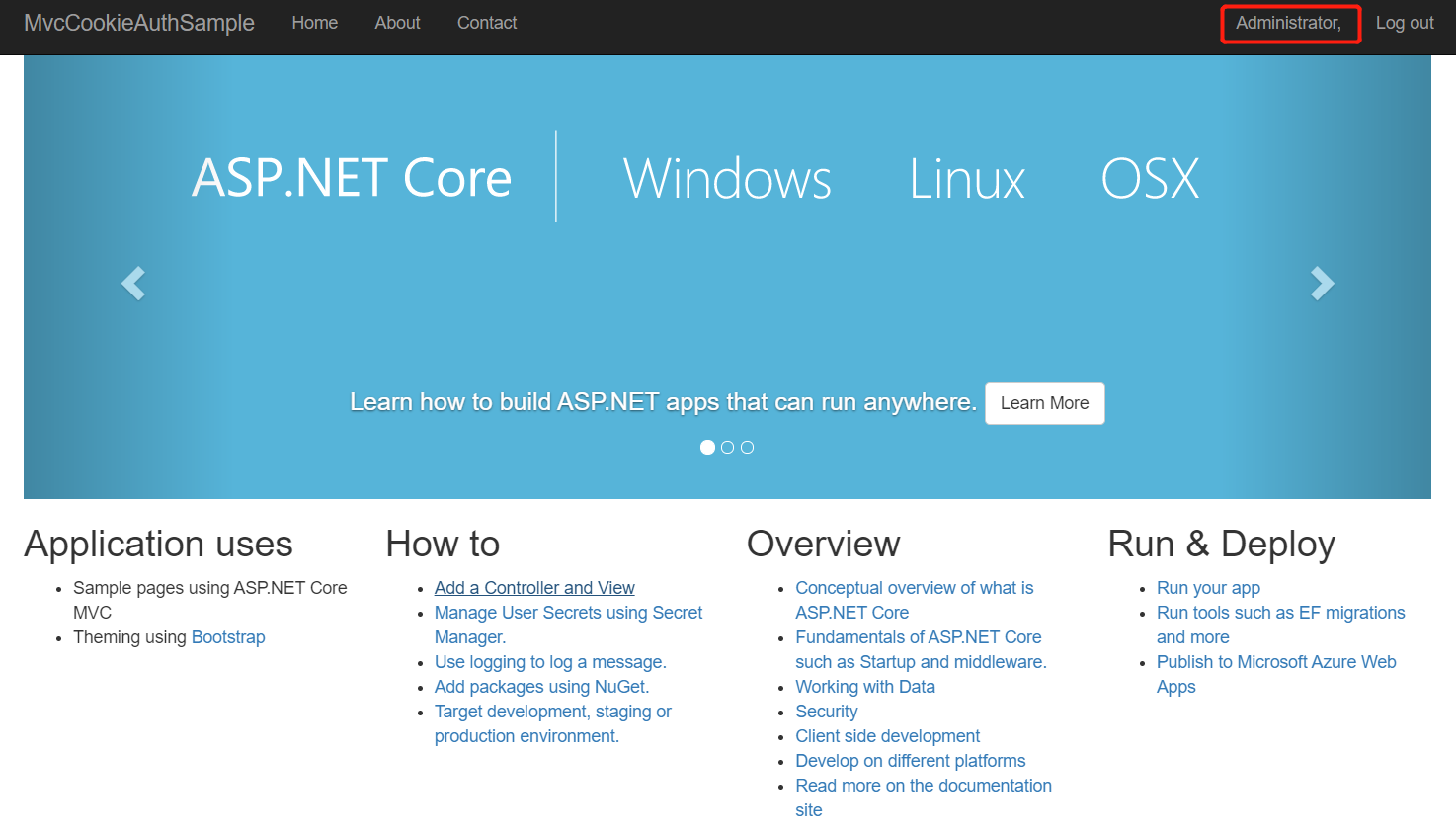
本作品采用知识共享署名-非商业性使用-相同方式共享 4.0 国际许可协议进行许可。
欢迎转载、使用、重新发布,但务必保留文章署名 郑子铭 (包含链接: http://www.cnblogs.com/MingsonZheng/ ),不得用于商业目的,基于本文修改后的作品务必以相同的许可发布。
如有任何疑问,请与我联系 (MingsonZheng@outlook.com) 。




 浙公网安备 33010602011771号
浙公网安备 33010602011771号